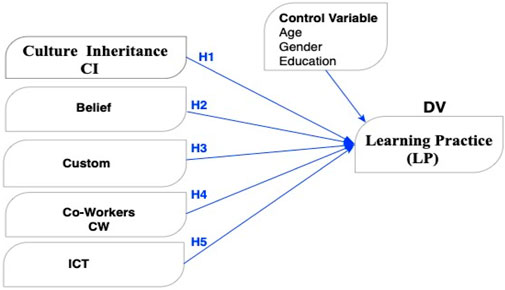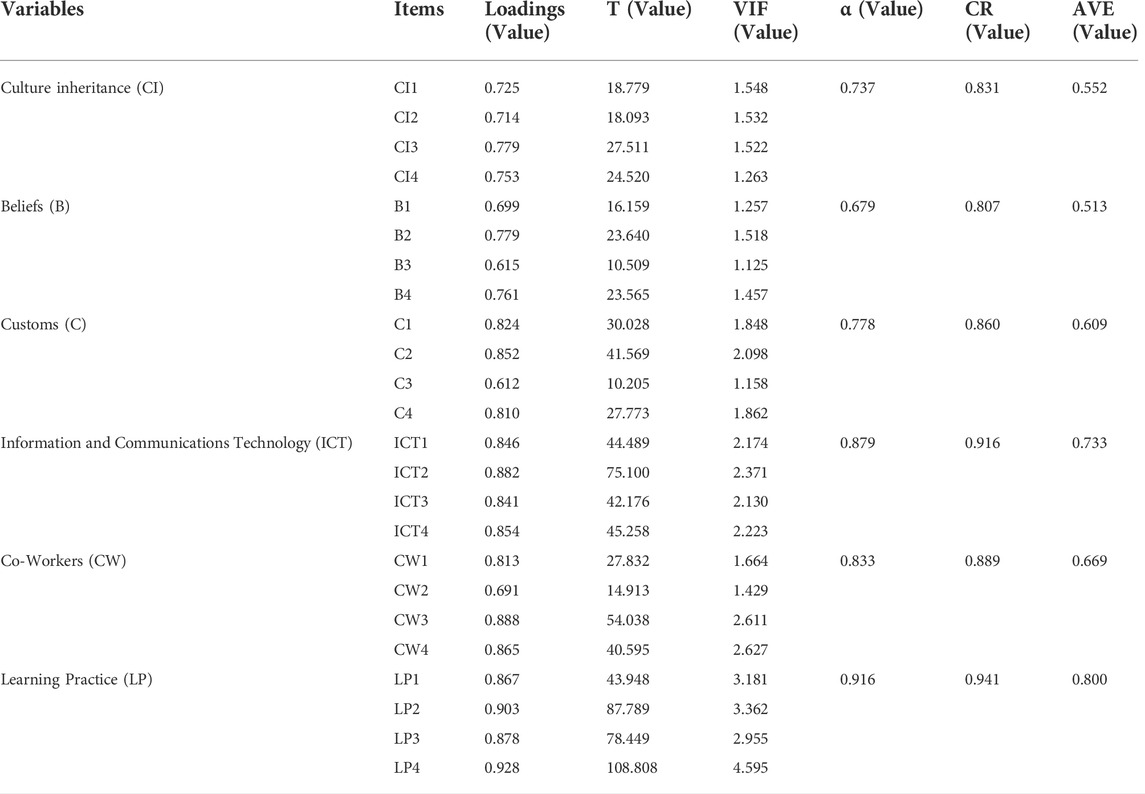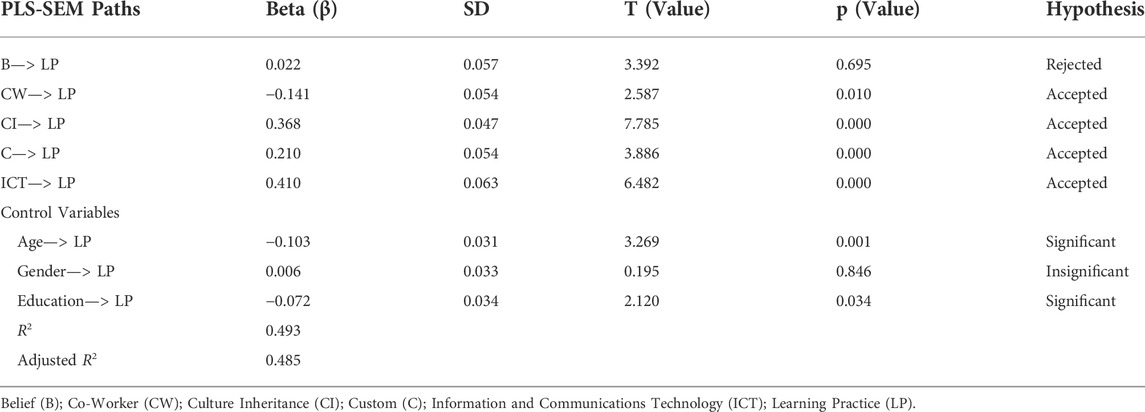- 1China University of Geosciences, Wuhan, China
- 2Guilin University of Technology, Guilin, China
A review of the relevant research reveals that the concept of “professional growth” is understood to refer to an all-encompassing developmental process that occurs throughout a person’s career as well as their entire life, and it is acknowledged as a phrase that is connected to other ideas. In addition, we can say that human attributes and circumstances are not the only factors that play a role in the process of professional development, but social and institutional experience also play a role in it. After that, this research is shown, which has personal dimensions for beliefs (B), co-workers (CW), culture inheritance (CI), customs (C), information and communications technology (ICT), and learning practice (LP). The research is formed to illustrate that promotion of professional growth in workplaces is connected to the mentioned variables. This study was based on the working experience of different backgrounds people. We tried to check how their attributes could influence their working practices and learning practices. A semi-structured questionnaire was adopted from existing literature and modified as per the study area. B > LP (β = 0.022; p 0.010), CI- > LP (β = 0.368; p 0.000), C- > LP (β = 0.210; p 0.000), and ICT- > LP (β = 0.410; p 0.000) were found to be significant using PLS-SEM direct path analysis.These results offer support to hypotheses H1, H3-H6 accepted and H2 rejected. As control variables, we looked at the respondents’ age, education, and gender. Gender (β = 0.006; p 0.846) showed insignificant relationships with LP, whereas age (β = −0.103; p 0.001) and education (β = −0.072; p 0.034) showed significant relationships with the dependent variable. gender does not have any relationship with learning practices (LP), but age and education can be favorable control variables, and an aged and experienced person can have more impacts on LP and impacts on independent variables.
1 Introduction
Culture is something that should be valued by every individual because of the myriad ways in which it influences both day-to-day living and the workplace. Even though learning to function in new cultural contexts has been a struggle for adults for a very long time, relatively little is understood about the mechanisms that underlie this form of learning (Elliott. 2019). According to the findings of different research, situated cognition is the theoretical framework that is the most helpful for comprehending cultural learning (Oyserman and Sorensen., 2013). This way of culture has a direct influence on several different aspects of cultural study, including how a new culture is learned, how it might be taught, and how to link previous cultures if you move to a different cultural environment (Lave. 2021). To be more explicit, given that all of us normally originate from different cultural, religious, and social backgrounds, how we conduct business may or may not be influenced by this fact. Due to the challenges associated with promoting reflective beliefs during practical teaching, one may conclude that certain methods utilized in teacher education, such as eliciting implicit conceptions or beliefs, may not be the most effective choice (Winitzky & Kauchak, 1997). The support of one’s coworkers has emerged as an essential component of the social support system provided at work, serving as a buffer against the constraints imposed by business (Hobfoll and Lerman, 1989). Organizations place a high value on the support and relationships that employees have with one another as a valuable resource for their work. As a consequence of this, the influence of support from coworkers as a kind of social support on the willingness to participate in group activities and educational pursuits is being researched as a direct result of the Conservation of Resources (COR) hypothesis (Dutta and Rangnekar, 2022). The dynamic relationship between technology, technological practice, and learning practices is an important phenomenon that needs to be explored. The role of information and communication technology (ICT) in learning practices is increasingly gaining importance in the working environment (Leach and Moon., 2000). Operationally, ICT has helped in many ways at work, and it may have an impact on our learning abilities as well. Pedagogically, it has enabled online, hybrid, and technology-enhanced learning as well as a host of other capabilities, from learning management systems to learning information systems (Hall and Higgins, 2005). ICT is now embedded in every aspect of working life. ICT is found to increase the value of learning practices (Bimrose et al., 2011; Szilárd et al., 2018). It has helped in the growth of research, expanding horizons for business mainly with limited accessibility. There are always two sides to the coin, and in this case, inaccessibility, economic disparity, and ineffective implementation of ICT have also created impediments to effectively adopting and diffusing integration of ICT (Ebrahim and Irani, 2005). This volume is a collection of interventions and collaborative practices across the world that showcase the multifaceted ways in which various institutions have been engaged in supporting teaching and learning with the use of technology and how it is equipping our future generation with the skills required to face a changing job market. Professional growth is viewed as an overall developmental process that occurs during one’s career and lifespan and is understood as a phrase that overlaps with other related ideas, according to an analysis of the pertinent research (Pylväs et al., 2022). Furthermore, we contend that, in addition to individual characteristics and circumstances, social and institutional settings have a role in professional development. After that, this research is shown, which personal dimensions for belief (B), co-worker (CW), culture inheritance (CI), custom (C), information and communications technology (ICT), and learning practice (LP). The research is formed to illustrate that promotion of professional growth in workplaces is connected to the mentioned variables. Age, gender, and educational level are important demographic characteristics of a sample that might affect and improve the link between the independent and dependent variables (Mustafa, Qiao, et al., 2022a; Mustafa, Tengyue, Qiao, et al., 2022b; Mustafa, Tengyue, Jamil, et al., 2022c). Some research has been done that suggests environmental knowledge does not substantially impact females’ intentions to use environmentally friendly items; however, it does have a large influence on males’ intentions. The goals of this study were to 1) look at how culture is passed down and what role ICT plays in learning practices; 2) use a PLS-SEM approach to look at some attributes and how they affect learning practices. Education, age, and gender may all have an impact on DV. Based on our literature review, we developed the following hypothesis: (Figure 1)
H1: Culture Inheritance has a positive relationship with Learning Practice.
H2: Belief has a positive relationship with Learning Practice.
H3: Custom has a positive relationship with Learning Practice.
H4: Co-Worker influence has a positive relationship with Learning Practice.
H5: Information and Communications Technology has a positive relationship with Learning Practice.
2 Materials and methods
2.1 Data sources and data preparation
This study was founded on the work experiences of people from various backgrounds. We attempted to investigate how distinctive traits can influence their working and learning practices. A semi-structured questionnaire was adapted from previously published material and tailored to the demands of the study (Sohail et al., 2022a; Sohail et al., 2022b). When developing the objectives of the study and collecting data from people, basic research ethics were considered, and participants in the study were given a full explanation of the study’s goals (Rasool et al., 2017). Furthermore, the participants were informed that the information they supplied would be used solely for research purposes and that they were under no obligation to respond to the questions posed to them (McCusker and Gunaydin, 2015; Sohail et al., 2019; Sohail et al., 2021; Sohail et al., 2022c). The research’s major indicators were determined as follows: beliefs (B), coworkers (CW), cultural inheritance (CI), customs (C), information and communications technology (ICT), and learning methods (LP). A total of 500 completed questionnaires were collected from the study region for this study, and a pre-test was undertaken to assess the reliability of the data and eliminate any discrepancies that may have arisen. This information was acquired from a variety of people who work for multinational corporations. The data was collected online via various social applications and email. WeChat was also employed. Following completion of data collection, the information was transmitted to PLS-SEM and SPSS 24 for further analysis. PLS-SEM is used to analyze data to check the relationship between variables because it is one of the most effective methods for predicting outcomes and because it is the method that is most commonly recommended for predicting and assessing explained variables to account for the greatest potential variance (Hair, Howard, and Nitzl 2020). use PLS-SEM to analyze data to check the relationship between variables because it is one of the most effective methods for predicting outcomes and because it is the method that is most frequently recommended for predicting and assessing explained variables to account for the greatest potential variance (Hair, Howard, and Nitzl 2020). PLS-SEM allows for the use of lower sample size while yielding conclusions of greater quality than other approaches. Aside from that, it can execute concurrent internal and external processing on all models, which is a highly helpful feature. It is also possible to investigate complex route models using this method of data collection (Hair and Sarstedt. 2021). Recent academic research (Mustafa, Qiao, et al., 2022a) reveals that the PLS-SEM technique’s appeal in management science may be at least partially related to the method’s prospective benefits. As a result, the PLS-SEM methodology looks to be the best option for this inquiry. A two-stage analysis is more successful than a single-stage analysis since the model compensates for non-linear interactions across accounts. To ensure the validity and reliability of the construct assessments, a route modeling technique based on PLS is tested not once but twice. First, convergent validity is investigated to see if it is dependable and valid. The structural model is next examined to see if it can be used to construct an inner model or establish a relationship between the latent components.
3 Results and discussion
This research is based on people’s backgrounds and personal experiences of life and their impacts on their learning practices. It is important to know how these indicators can have on their working life. A total number of 500 completed questionnaires were collected to analyze the future relationship among DV, IV, and control variables. To better comprehend our study sample and its characteristics, we have collated the participant’s age, gender, and education. Information about the demographics of our whole sample (500 people) is provided in Table 1.
According to prior research findings, scholars believe that some multivariate hypotheses should be tested before starting with a multivariate investigation (Mustafa, Qiao, et al., 2022a). When evaluating measurement models, it is critical to assess both the convergent and discriminant validity of the indicators and notions being used (Hair, Howard, and Nitzl 2020). We put the construct indicators through their paces by putting them through a series of tests to see if they provide an adequate evaluation of the research variables. We did this to determine whether they provide an appropriate evaluation of the study variables. We utilized Cronbach’s alpha () in conjunction with item loading to determine whether or not the instrument in question was reliable. Both the average variance extracted (AVE) and the composite reliability (CR) are measures that are used to show the level of variance in indicators that are compensated for by the latent construct. The abbreviations for AVE and CR are AVE and CR, respectively. The abbreviations for these two separate measures are AVE and CR, respectively. The factor loadings on the linked structures are used as the basis for a study of the dependability of each item (Table 2; Figure 2). For an outside load to be considered significant for a component, it must be more than or equal to 0.6. Hair and colleagues (2020). Cronbach’s alpha values for all constructs should be greater than or very close to the recommended cutoff of 0.7 to generate a greater sense of trust. This is because the cutoff was designed to assure dependability. According to Werts, Linn, and Joreskog (1974), this will help ensure the reliability of the results. In addition to Cronbach’s alpha, the composite dependability (CR) of the constructs was examined. This procedure was employed instead of the traditional one (Werts, Linn, and Joreskog 1974). According to the commonly accepted criteria, a reliability level of 0.6–0.7 is deemed satisfactory, while a level of 0.8 or higher is considered goes greater than 0.95, on the other hand, are not always deemed positive because they may indicate redundancy (Hulin, Netemeyer, and Cudeck, 2001). These findings are supported further by the results’ high high-reliability, which are all larger than 0.7. If a group of items is tightly related to one another, they are said to have a high Cronbach’s alpha. This internal consistency metric is called after its namesake. It is taken into account as a measure of the scale’s dependability. Because the measure has a “high” alpha value, it does not have to be unidimensional. Cronbach’s Alpha (Cronbach’s Alpha) for Beliefs (B) is 0.679, Co-Worker (CW) is 0.833, Culture Inheritance (CI) is 0.737, and Custom (C) is 0.778. Learning Practice (LP) has a score of 0.916, while Information and Communications Technology (ICT) has a value of 0.879. Table 1 shows that the AVE convergent validity estimations were either greater than or equal to 0.50. (Hair, Howard, and Nitzl 2020; Hair, Jr et al., 2021). From these results, it is clear that the dataset has enough information to be worth looking into further.
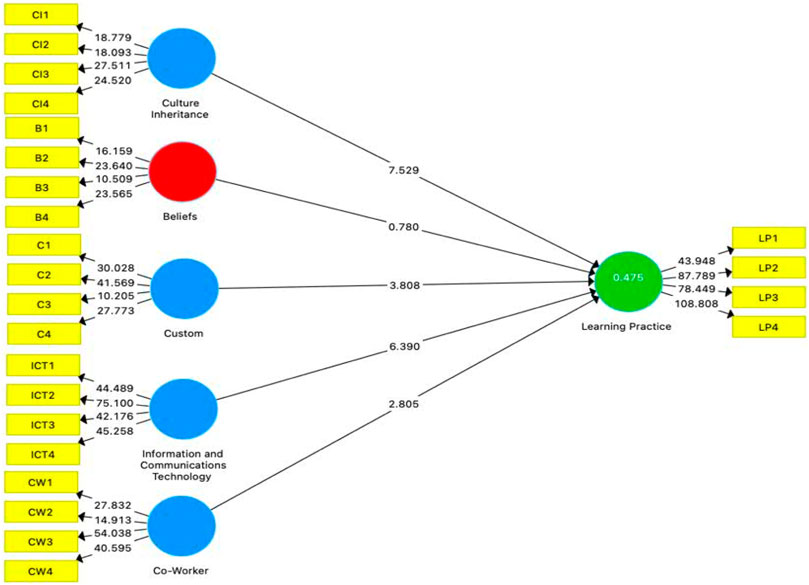
FIGURE 2. Measurement model, (Green and blue variables = Significant; Green and red variables = Insignificant).
The Fronell-Larcker criterion is one of the most often used approaches for identifying whether or not measurement models have discriminant validity. To satisfy this criterion, the square root of the average variance retrieved by a construct must be greater than the correlation between the construct at issue and any other construct. The Fornell-Larcker criterion and heterotrait-monotrait (HTMT) ratios are used to assess the discriminant validity of the proposed model (Hair et al., 2020; Hair and Sarstedt, 2021). Table 3 clearly shows that the Fornell-Larcker criteria were used to verify the test’s discriminant validity, as indicated by the variables having the highest significant correlation in each column (Fornell & Larcker, 1981). The HTMT ratio methodology is a revolutionary method proposed by Henseler, et al. (2015) as an innovative approach to determining whether or not discriminant validity exists. They maintained that, despite being effective in evaluating discriminant validity, the Fornell-Larcker criteria were unable to distinguish between the absence and presence of discriminant validity, even if the criteria were adequate for evaluating discriminant validity. This immediately necessitated the use of the HTMT within the framework of the technique for evaluating discriminant validity. The HTMT values for each of the several parameters investigated during this study are shown in Table 4, which summarizes the investigation’s findings. For the experiment to be successful and meet the conditions, all of the variables’ HTMT values must be less than 0.90. The HTMT values in this study are all less than 0.90, confirming the variables’ discriminant validity. For the experiment to be successful and meet the conditions, all of the variables’ HTMT values must be less than 0.90 (Henseler, Ringle, and Sarstedt, 2015).
The PLS-SEM evaluation procedure is divided into several stages, the second of which is the analysis of the structural model. When analyzing the structural path model, some of the factors that ought to be taken into consideration include the predictive relevance of the model, multicollinearity, the empirical importance of the route coefficients, and the degree of confidence. In addition to this, it is necessary to conduct a trustworthiness analysis of the structural path model. The structural model was examined in this study by making use of the guidelines that were supplied by Hair Jr et al., 2021) to comprehend the data. We put a model through its paces to study the direct impact that several different factors had on LP, and we did so by using the model. As a consequence of this, the outcomes of the PLS-SEM path analysis (shown in Figure 3) revealed an R2 value of 0.7, which demonstrated that our model is accurate (Table 5).
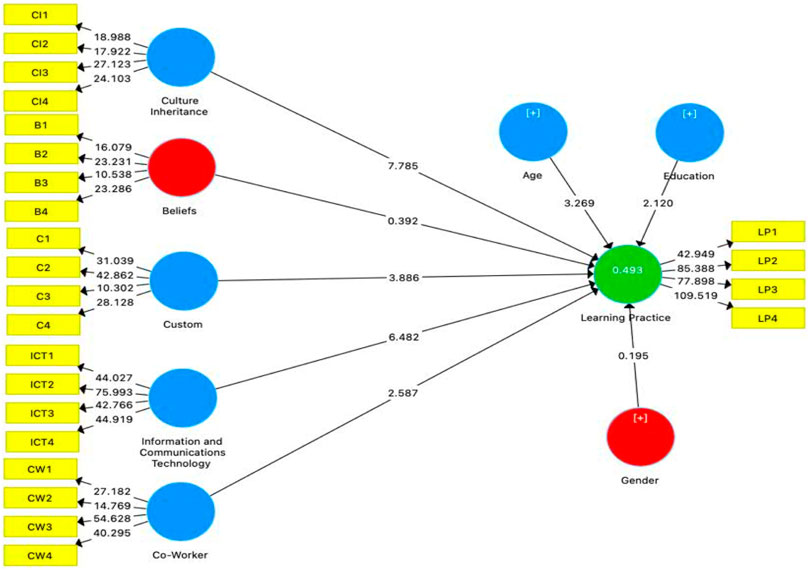
FIGURE 3. PLS-SEM Path Model (Green and blue variables = Significant; Green and red variables = Insignificant).
PLS-SEM was used to examine relationships between variables such as Belief (B), Co-Worker (CW), Culture Inheritance (CI), Custom (C), Information and Communications Technology (ICT), and Learning Practice (LP).To test the validity of the hypotheses that had been put forward previously, we began by examining the causal relationships that were already known to exist between the different variables. Following that, we carried out a bootstrapping test using 5,000 replicates to evaluate the degree to which our findings were consistent with the hypothesis (Mustafa, Qiao, et al., 2022a). B > LP (β = 0.022; p 0.010), CI- > LP (β = 0.368; p 0.000), C- > LP (β = 0.210; p 0.000), and ICT- > LP (β = 0.410; p 0.000) were found to be significant using PLS-SEM direct path analysis.These results offer support to hypotheses H1, H3-H6 accepted and H2 rejected. As per the results of this model, we can say Co-Worker (CW); Culture Inheritance (CI); Custom (C); Information and Communications Technology (ICT); and have a strong association with Learning Practice (LP). We can say our learning particles can be effective with our personal beliefs, customs, ICT, and other related factors. We also looked at the respondents’ age, education, and gender as control variables, and found that gender (β = 0.006; p 0.846) had insignificant relationships with LP, whereas age (β = −0.103; p 0.001) and education (β = −0.072; p 0.034) had significant relationships with the dependent variable. Gender has no effect on learning practices (LP), but age and education can be beneficial control variables, and an older and more experienced person can have a greater impact on LP and independent variables (Table 5 and Figure 3). Mathematical models can describe in detail the real relationships that exist between the parameters used to characterize water quality. This analysis not only offers a method for making forecasts but also offers a way to determine the nature of the relationship that exists between the variables. The multivariate parameters were subjected to a Pearson’s correlation analysis, and the results show that there is a significant relationship between several of the variables (highlighted numbers). There is a positive association, ranging from moderate to high, between all of the variables. The descriptive statistics and correlation coefficients of these selected variables are presented in Table 6, which may be seen below. Belief (B), Co-Worker (CW), Culture Inheritance (CI), Custom (C), Information and Communications Technology (ICT), Learning Practice (LP), Gender, Education, and Age (GEA), and Information and Communications Technology (ICT). The concept of correlation refers to a method that can be used to analyze the relationship between two or more variables. The correlation values range from plus one hundred to minus one hundred. The magnitude of the number, with one representing the highest possible value, is used to determine the strength of the link. In the current research, correlation values of selected variables are found to be significant among all variables, and there is a moderate to the high degree of correlation between the various variables. All of the variables were determined to be significant, and there was either a weak or moderately strong, positive or negative correlation between all of the variables that were selected (Table 6).
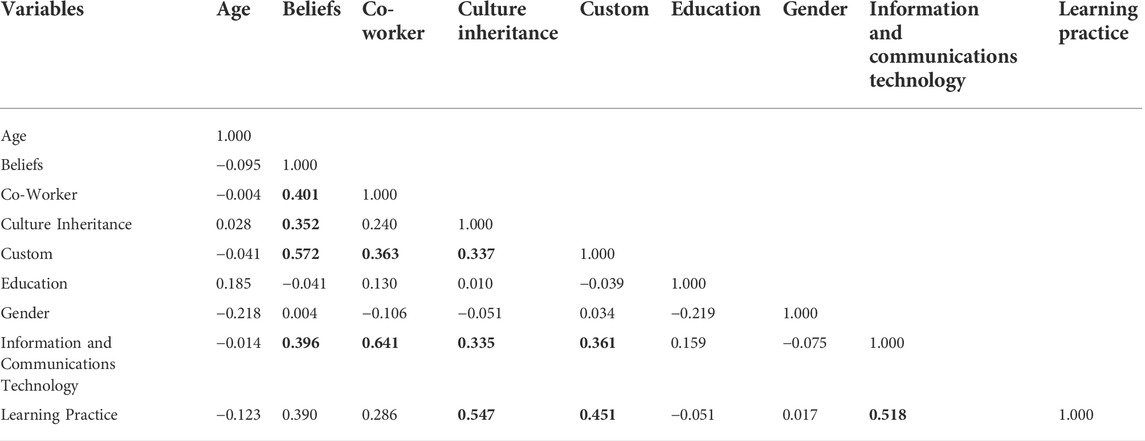
TABLE 6. Correlation among variable. Bold Values indicate moderate to high correlation among variables.
4 Conclusion
Professional growth is dependent on social and institutional contexts as well as personal attributes and circumstances. Following that, this research contains personal dimensions such as beliefs (B), co-workers (CW), culture inheritance (CI), customs (C), information and communications technology (ICT), and learning practice (LP). The research is formed to illustrate that promotion of professional growth in workplaces is connected to the mentioned variables. This study was based on the working experience of different backgrounds people. We tried to check how their attributes could influence their working practices and learning practices. A semi-structured questionnaire was adopted from existing literature and modified as per the study area. PLS-SEM direct path analysis revealed B > LP was insignificant, while CW > LP, CI > LP, C > LP, and ICT > LP are significant. These results offer support to hypotheses H1, H3-H6 accepted and H2 rejected. We have also looked at the levels of age, education, and gender of the respondents as control variables. Gender showed insignificant relationships with LP, and age and education showed significant relationships with the dependent variable. It means gender does not have any relationship with learning practices (LP), but age and education can be favorable control variables, and an aged and experienced person can have more impacts on LP and impacts on independent variables. However, the primary findings of this study can be applied not only in places where adaptations to climate change are currently insufficient but also in other places. The study will help get the right kinds of monitoring and public policies put in place to make sure integration and sustainability, and it will also help policymakers help farmers both in their everyday lives and in their farming work.
Data availability statement
The original contributions presented in the study are included in the article/Supplementary Material, further inquiries can be directed to the corresponding author.
Ethics Statement
Ethical review and approval was not required for the study on human participants in accordance with the local legislation and institutional requirements. Written informed consent from the participants was not required to participate in this study in accordance with the national legislation and the institutional requirements.
Author contributions
FG; Data Collection ZM; Writing, HD; Supervising.
Conflict of interest
The authors declare that the research was conducted in the absence of any commercial or financial relationships that could be construed as a potential conflict of interest.
Publisher’s note
All claims expressed in this article are solely those of the authors and do not necessarily represent those of their affiliated organizations, or those of the publisher, the editors and the reviewers. Any product that may be evaluated in this article, or claim that may be made by its manufacturer, is not guaranteed or endorsed by the publisher.
References
Bimrose, J., Hughes, D., and Barnes, S. A. (2011). Integrating new technologies into careers practice: Extending the knowledge base. London: UKCES.
Dutta, A., and Rangnekar, S. (2022). Preference for teamwork, personal interaction, and communities of practice: Does co-worker support matter? VINE J. Inf. Knowl. Manag. Syst. (ahead-of-print). doi:10.1108/vjikms-11-2021-0284
Ebrahim, Z., and Irani, Z. (2005). E-Government adoption: Architecture and barriers. Bus. process Manag. J. 11, 589–611. doi:10.1108/14637150510619902
Elliott, A. (2019). The culture of AI: Everyday life and the digital revolution. Oxfordshire, England, UK: Routledge.
Fornell, C., and Larcker, D. F. (1981). Structural equation models with unobservable variables and measurement error: Algebra and statistics. J. Mark. Res. 18, 382–388.
Hair, J. F., Howard, M. C., and Nitzl, C. (2020). Assessing measurement model quality in PLS-SEM using confirmatory composite analysis. J. Bus. Res. 109, 101–110. doi:10.1016/j.jbusres.2019.11.069
Hair, J. F., and Sarstedt, M. (2021). Data, measurement, and causal inferences in machine learning: Opportunities and challenges for marketing. J. Mark. Theory Pract. 29 (1), 65–77. doi:10.1080/10696679.2020.1860683
Hall, I., and Higgins, S. (2005). Primary school students' perceptions of interactive whiteboards. J. Comput. assisted Learn. 21 (2), 102–117. doi:10.1111/j.1365-2729.2005.00118.x
Henseler, J., Ringle, C. M., and Sarstedt, M. (2015). A new criterion for assessing discriminant validity in variance-based structural equation modeling. J. Acad. Mark. Sci. 43 (1), 115–135. doi:10.1007/s11747-014-0403-8
Hobfoll, S. E., and Lerman, M. (1989). Predicting receipt of social support: A longitudinal study of parents' reactions to their child's illness. Health Psychol. 8 (1), 61–77. doi:10.1037/0278-6133.8.1.61
Hulin, C., Netemeyer, R., and Cudeck, R. (2001). Can a reliability coefficient be too high? J. Consumer Psychol. 10, 55–58. doi:10.2307/1480474
Lave, J. (2021). “The culture of acquisition and the practice of understanding 1,” in Situated cognition (Oxfordshire, England, UK: Routledge), 17–35.
Leach, J., and Moon, B. (2000). Pedagogy, information and communications technology and teachers' professional knowledge. Curric. J. 11 (3), 385–404. doi:10.1080/09585170050200585
McCusker, K., and Gunaydin, S. (2015). Research using qualitative, quantitative or mixed methods and choice based on the research. Perfusion 30 (7), 537–542. doi:10.1177/0267659114559116
Mustafa, S., Qiao, Y., Yan, X., Anwar, A., Tengyue, H., and Rana, S. (2022b). Digital students' satisfaction with and intention to use online teaching modes, role of big five personality traits. Front. Psychol. 13, 956281. doi:10.3389/fpsyg.2022.956281
Mustafa, S., Tengyue, H., Jamil, K., Qiao, Y., and Nawaz, M. (2022c). Role of eco-friendly products in the revival of developing countries’ economies and achieving a sustainable green economy. Front. Environ. Sci. 10, 955245. doi:10.3389/fenvs.2022.955245
Mustafa, S., Tengyue, H., Qiao, Y., Sha, S. K., and Sun, R. (2022a). How a successful implementation and sustainable growth of e-commerce can be achieved in developing countries; a pathway towards green economy. Front. Environ. Sci. 10. doi:10.3389/fenvs.2022.940659
Oyserman, D., and Sorensen, N. (2013). “Understanding cultural syndrome effects on what and how we think: A situated cognition model,” in Understanding culture (Psychology Press), 39–66.
Pylväs, L., Li, J., and Nokelainen, P. (2022). “Professional growth and workplace learning,” in Research approaches on workplace learning (Cham: Springer), 137–155.
Rasool, A., Jundong, H., and Sohail, M. T. (2017). Relationship of intrinsic and extrinsic rewards on job motivation and job satisfaction of expatriates in China. J. Appl. Sci. 17 (3), 116–125. doi:10.3923/jas.2017.116.125
Sohail, M. T., Elkaeed, E. B., Irfan, M., Acevedo-Duque, Á., and Mustafa, S. (2022a). Agricultural communities’ risk assessment and the effects of climate change: A pathway toward green productivity and sustainable development. Front. Environ. Sci. 10, 193. doi:10.3389/fenvs.2022.948016
Sohail, M. T., Mahfooz, Y., Azam, K., Yen, Y., Genfu, L., and Fahad, S. (2019). Impacts of urbanization and land cover dynamics on underground water in Islamabad, Pakistan. Desalin Water Treat. 159, 402–411. doi:10.5004/dwt.2019.24156
Sohail, M. T., Majeed, M. T., Shaikh, P. A., and Andlib, Z. (2022c). Environmental costs of political instability in Pakistan: Policy options for clean energy consumption and environment. Environ. Sci. Pollut. Res. 29 (17), 25184–25193. doi:10.1007/s11356-021-17646-5
Sohail, M. T., Mustafa, S., Ma, M., and Riaz, S. (2022b). Agricultural communities’ risk assessment and the effects of climate change: A pathway toward green productivity and sustainable development. Front. Environ. Sci. 10, 948016. doi:10.3389/fenvs.2022.948016
Sohail, M. T., Ullah, S., Majeed, M. T., and Usman, A. (2021). Pakistan management of green transportation and environmental pollution: A nonlinear ARDL analysis. Environ. Sci. Pollut. Res. 28 (23), 29046–29055. doi:10.1007/s11356-021-12654-x
Szilárd, S., Benedek, A., and Ionel-Cioca, L. (2018). Soft skills development needs and methods in micro-companies of ICT sector. Procedia - Soc. Behav. Sci. 238, 94–103. doi:10.1016/j.sbspro.2018.03.012
Werts, C. E., Linn, R. L., and Jöreskog, K. G. (1974). Intraclass reliability estimates: Testing structural assumptions. Educ. Psychol. Meas. 34 (1), 25–33. doi:10.1177/001316447403400104
Keywords: ICT-information and communication technologies, practice in learning, working environment, belief, custom
Citation: Guanghui F, Meng Z and Delin H (2022) An empirical analysis of cultural inheritance and ICT role on learning practice in a working environment; A PLS-SEM analysis. Front. Environ. Sci. 10:1010713. doi: 10.3389/fenvs.2022.1010713
Received: 03 August 2022; Accepted: 12 August 2022;
Published: 05 September 2022.
Edited by:
Muhammad Tayyab Sohail, Xiangtan University, ChinaReviewed by:
Sidra Sohail, Pakistan Institute of Development Economics, PakistanMuhsan Ehsan, Bahria University, Pakistan
Copyright © 2022 Guanghui, Meng and Delin. This is an open-access article distributed under the terms of the Creative Commons Attribution License (CC BY). The use, distribution or reproduction in other forums is permitted, provided the original author(s) and the copyright owner(s) are credited and that the original publication in this journal is cited, in accordance with accepted academic practice. No use, distribution or reproduction is permitted which does not comply with these terms.
*Correspondence: Huang Delin, ZGxodWFuZzEwMzBAMTYzLmNvbQ==
 Feng Guanghui
Feng Guanghui Zhou Meng2
Zhou Meng2